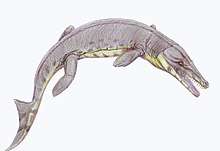Neosuchia
Neosuchia is a clade within Mesoeucrocodylia that includes all modern extant crocodilians and their closest fossil relatives.[1] It is defined as the most inclusive clade containing all crocodylomorphs more closely related to Crocodylus niloticus (the Nile Crocodile) than to Notosuchus terrestris.[2] Neosuchia is very diverse and may be polyphyletic, as the clade has undergone many revisions since it was first named in 1988.[3] Neosuchians first appear in the Early Jurassic with the earliest known goniopholid Calsoyasuchus, which lived during the Sinemurian and Pliensbachian stages.[4]
| Neosuchia | |
|---|---|
 | |
| Goniopholis | |
| Scientific classification | |
| Kingdom: | Animalia |
| Phylum: | Chordata |
| Class: | Reptilia |
| Clade: | Metasuchia |
| Clade: | Neosuchia |
| Suborders and families | |
Characteristics
A tooth notch between the maxilla and premaxilla is a basal characteristic of the Neosuchia, although it is lost in some more derived forms, most notably alligatorids.
Classification
- Stem Neosuchia
- Genus Deltasuchus
- Genus Khoratosuchus
- Genus Lisboasaurus
- Genus Paluxysuchus
- Genus Stolokrosuchus
- Genus Wahasuchus?
- Family Susisuchidae
- Suborder Thalattosuchia
- Genus Pelagosaurus
- Family Teleosauridae
- Superfamily Metriorhynchoidea
- Clade Coelognathosuchia
- Family Goniopholididae
- Suborder Tethysuchia
- ?Family Elosuchidae
- Family Dyrosauridae
- Family Pholidosauridae
- Family Stomatosuchidae
- Family Bernissartiidae
- Genus Gilchristosuchus
- Suborder Eusuchia
Phylogeny
Below is a cladogram showing the phylogenetic relationships of neosuchians from Buscalioni et al., 2011:[5]
| Neosuchia |
| ||||||||||||||||||||||||||||||||||||||||||||||||||||||||||||||||||||||||||||||||||||||||||||||||||||||||||||||||||||||||||||||||||||||||||||||||||||||||||||||||||||||||||||||||||||||||||||||||||||||||||||||||||||||||||||||||||||||||||||||||||||||||||||||||||||||||||||||||||||||||||||||||||||||
In 2012, paleontologists Mario Bronzati, Felipe Chinaglia Montefeltro, and Max C. Langer conducted a broad phylogenetic analysis to produce supertrees of Crocodyliformes, including 184 species. The most parsimonious trees were highly resolved, meaning the phylogenetic relationships found in the analysis were highly likely. Below is a consensus tree from the study:[6]
| Neosuchia |
| ||||||||||||||||||||||||||||||||||||||||||||||||||||||||||||||||||||||||||||||||||||||||||||||||||||||||||||||||||||||||||||||||||||||||||||||||||||||||||||||||||||||||||||||||||||||||||||||||||||||||||||||||||||||||||||||||||||||||||||||||||||||||||||||||||||||||||||||||||||||||||||||||||||||||||||||||||||||||||||||||||||||||||||||||||||||||||||||||||||||||||||||||||||||||||||||||||||||||||||||||||||||||||||||||||||||||||||||||||||||||||||||||||||||||||||||||||||||||||||||||||||||||||||||||||||||||||||||||||||||||||||||||||||||||||||||||||||||||||||||||||||||||||||||||||||||||||||||||||
See also
- Koumpiodontosuchus aprosdokiti
References
- Wilson, J. A.; Malkani, M. S.; Gingerich, P. D. (2001). "New crocodyliform (Reptilia, Mesoeucrocodylia) from the Upper Cretaceous Pab Formation of Vitakri, Balochistan (Pakistan)" (PDF). Contributions from the Museum of Paleontology, University of Michigan. 30 (12): 321–336. Retrieved 2009-11-02.
- Larsson, H. C. E.; Sidor, C. A.; Gado, B.; Gado, B (2001). "The giant crocodyliform Sarcosuchus from the Cretaceous of Africa" (PDF). Science. 294 (5546): 1516–1519. doi:10.1126/science.1066521. PMID 11679634. Retrieved 2009-11-02.
- Benton, M. J. & Clark, J. M. (1998). Archosaur phylogeny and the relationships of the Crocodylia, p. 289-332. In Benton, M.J. (ed.), The Phylogeny and Classification of Tetrapods, Vol. 1 ., Clarendon Press, Oxford.
- Tykoski, R. S.; Rowe, T. B.; Ketcham, R. A.; Colbert, M. W. (2002). "Calsoyasuchus valliceps, a new crocodyliform from the Early Jurassic Kayenta Formation of Arizona" (PDF). Journal of Vertebrate Paleontology. 22 (3): 593–611. doi:10.1671/0272-4634(2002)022[0593:CVANCF]2.0.CO;2. Retrieved 2009-11-02.
- Buscalioni, A.D.; Piras, P.; Vullo, R.; Signore, M.; Barbera, C. (2011). "Early eusuchia crocodylomorpha from the vertebrate-rich Plattenkalk of Pietraroia (Lower Albian, southern Apennines, Italy)". Zoological Journal of the Linnean Society. 163: S199–S227. doi:10.1111/j.1096-3642.2011.00718.x.
- Bronzati, M.; Montefeltro, F. C.; Langer, M. C. (2012). "A species-level supertree of Crocodyliformes". Historical Biology. 24 (6): 598–606. doi:10.1080/08912963.2012.662680.
External links
- Neosuchia in the Paleobiology Database

